If you are a business owner, you may have heard about how vital search engine optimization (SEO) is. But how can it help fast-track your business’s growth, get more customers, and make a difference to your bottom line?
In more simple terms: Why do SEO?
1. It increases your organic share of voice
There are an estimated 3.5 billion searches on Google each day. To tap into this audience, you’ll need to do SEO.
One of the key benefits of SEO is increasing your organic share of voice (SOV). More organic SOV means more traffic, leads, and revenue for your business.
It also means more market share in your industry. We can see from the graph below that there is a strong relationship between SOV and market share.

At Ahrefs, we calculate organic SOV by dividing the traffic to the site by the total search traffic for all keywords.
In other words, if you only track one keyword and the top 10 positions are occupied by pages of your website, your SOV is 100%.
So how can you measure organic SOV?
We first need to create a new project in Ahrefs’ Rank Tracker and add our keywords for the website we want to track.
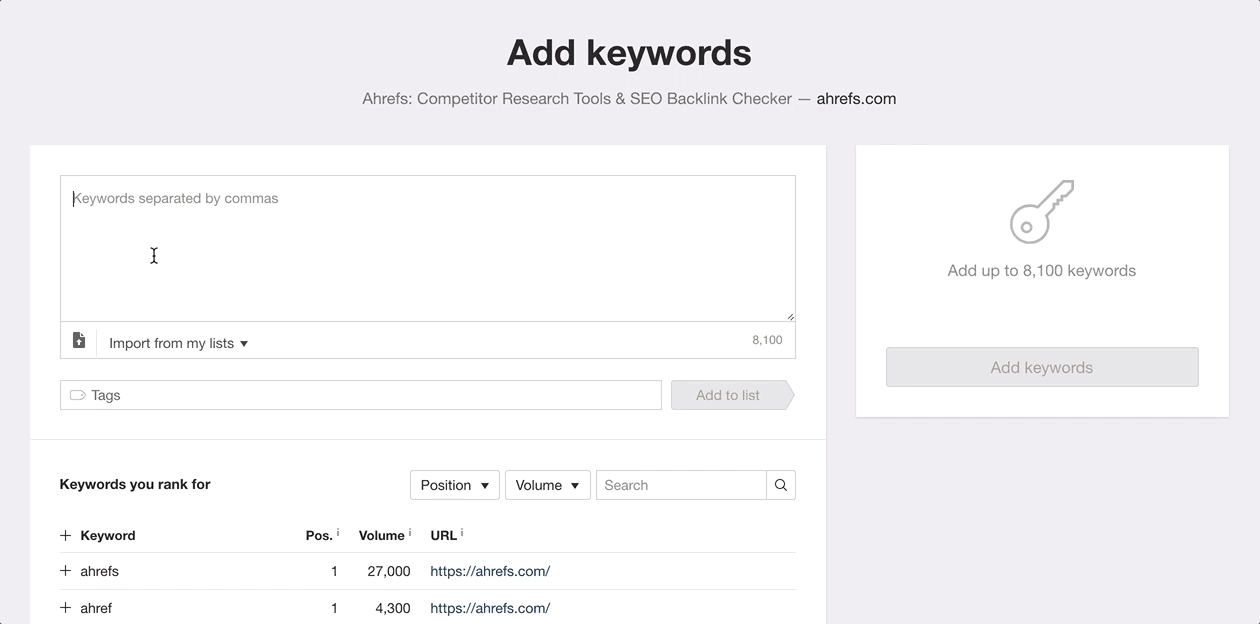
Once you have added a new project and added your keywords, you can go to the dashboard and check your SOV.
It should look something like this:
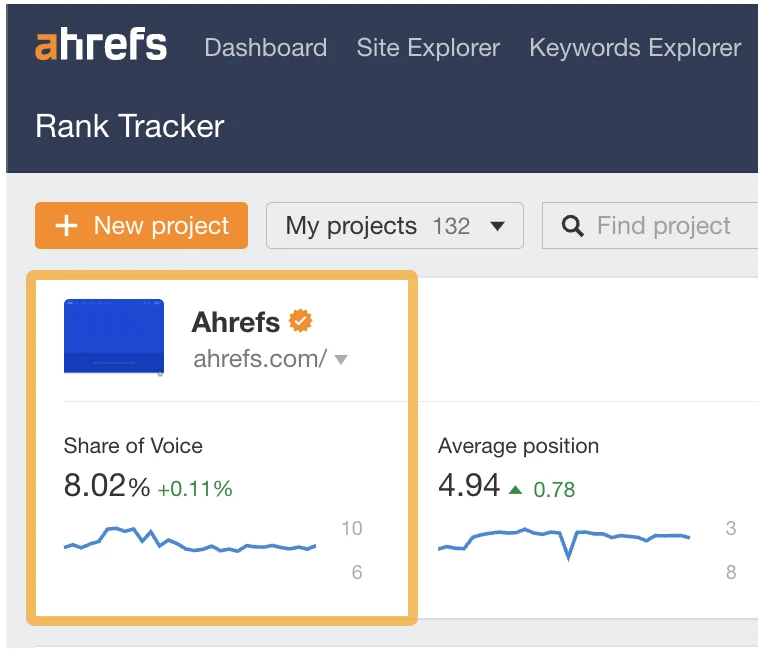
If you click through the SOV on the dashboard, you can look at your competitor’s SOV compared to your SOV.

If no competitors are showing in your dashboard, you can change that by:
- Going into Settings.
- Clicking on the Competitors tab.
- Clicking on + Add competitor.
Enter your competitors manually or press the + to add them from the list below that shows the keyword intersection.
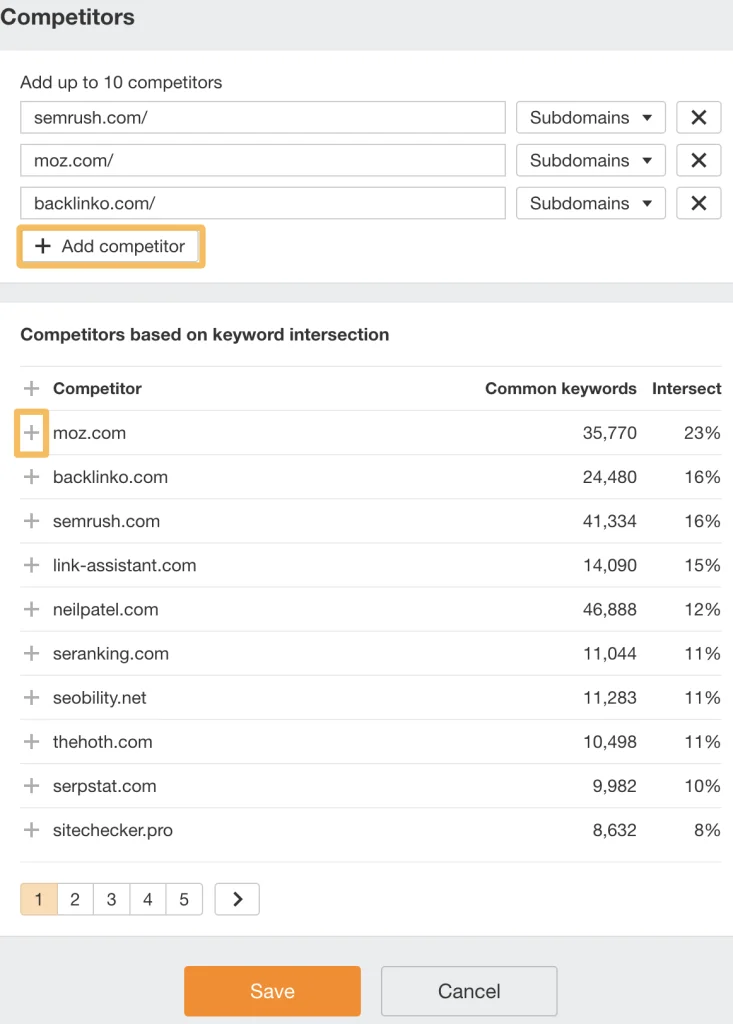
Once you are happy, click the Save button and return to the dashboard. You should now be able to compare your competitor’s SOV against your website’s SOV.
RECOMMENDATION
Check out Michal Pecánek’s article on SOV to get a detailed guide on how to measure SOV.
2. It’s less intrusive than other types of marketing
Intrusive marketing is annoying.
It may seem obvious. But when our lives are full of adverts, cold calls, and emails from random people trying to sell you their products all the time, it’s very advantageous to be an inbound marketing channel.

SEO targets people who are actively searching for your services or products.
Because of this, it’s excellent at converting—all you need to do is focus on what they are searching for.
You can find what your customers are searching for using Ahrefs’ Keywords Explorer.
Enter a relevant topic and go to the Matching terms report. Here, you’ll see many topics your customers are searching for, which you can target.
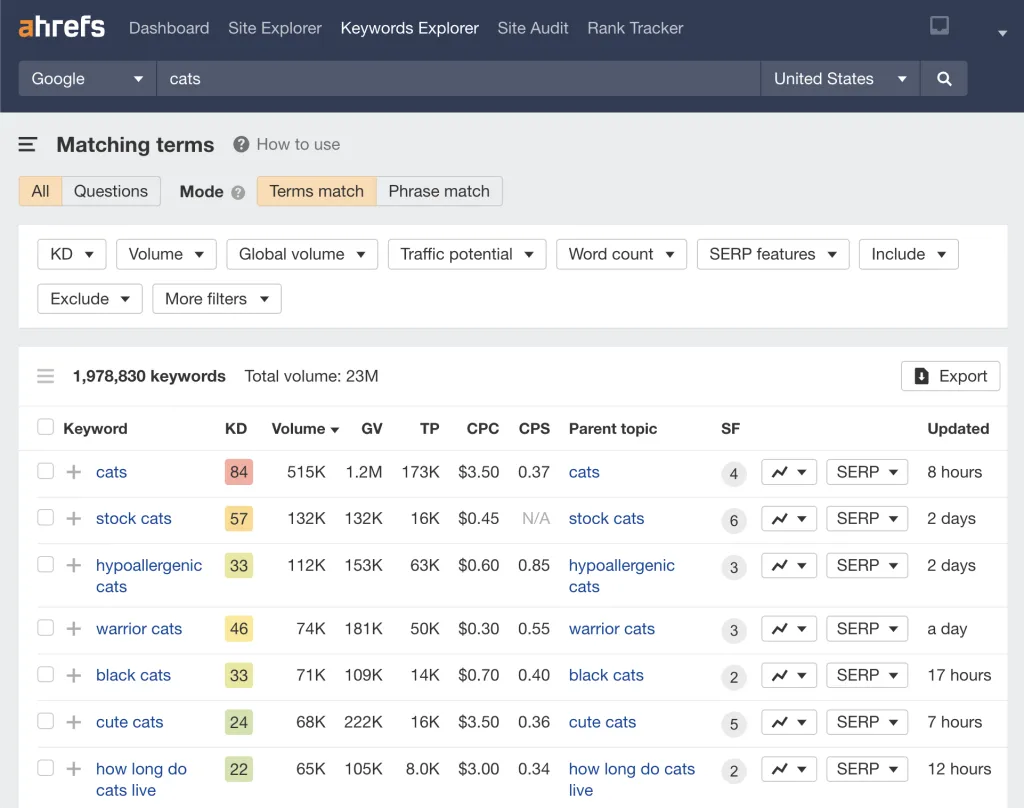
You can search, discover, and analyze keywords using our very own Ahrefs’ Keywords Explorer.
RECOMMENDATION
If you want to learn how to find, analyze, target, and prioritize keywords, check out our beginner’s guide to keyword research.
3. It’s long term
SEO is not just for Christmas.
In all, 45.6% of SEOs say SEO takes about three to six months. It may seem like a long time for the channel to work, but SEO is a long-term marketing channel where growth typically compounds over time. In other words, if you put the time and effort into SEO, the results will likely be well worth it.
Looking at Ahrefs’ organic traffic graph, most of our rapid growth occurred in the last year or so when our traffic started to compound.

Google’s algorithm updates mean that your website’s traffic will fluctuate. But as you can see from the graph, it’s a positive trend in the long term.
Over time, you should be able to rely on SEO to bring in a constant stream of traffic to your site.
When we asked ~4,300 SEOs how long SEO takes, they gave a variety of responses. But only 16.2% of SEOs said that SEO takes between one and three months.

I agree with the majority of SEOs here. But I would add a qualifier—that it depends on the type of website you are working on.
For example, if you set up a brand-new website, it will have little to no authority. This is because it will have no links pointing to it and will probably have minimal content on the site.
These elements are just some indicators or ways in which Google judges your website’s authority and decides which top results should be on its SERPs.
RECOMMENDATION
If you are improving the SEO of a website that’s been around for a few years, then the SEO will likely take effect faster. This is based on my experience, but you may get different results with your website.
4. It’s cost-effective
Unlike paying for PPC, organic search traffic is free.
If Ahrefs used PPC to pay for its organic traffic, Ahrefs’ Site Explorer estimates it would cost an eye-watering $2.3 million per month or $27.6 million per year.
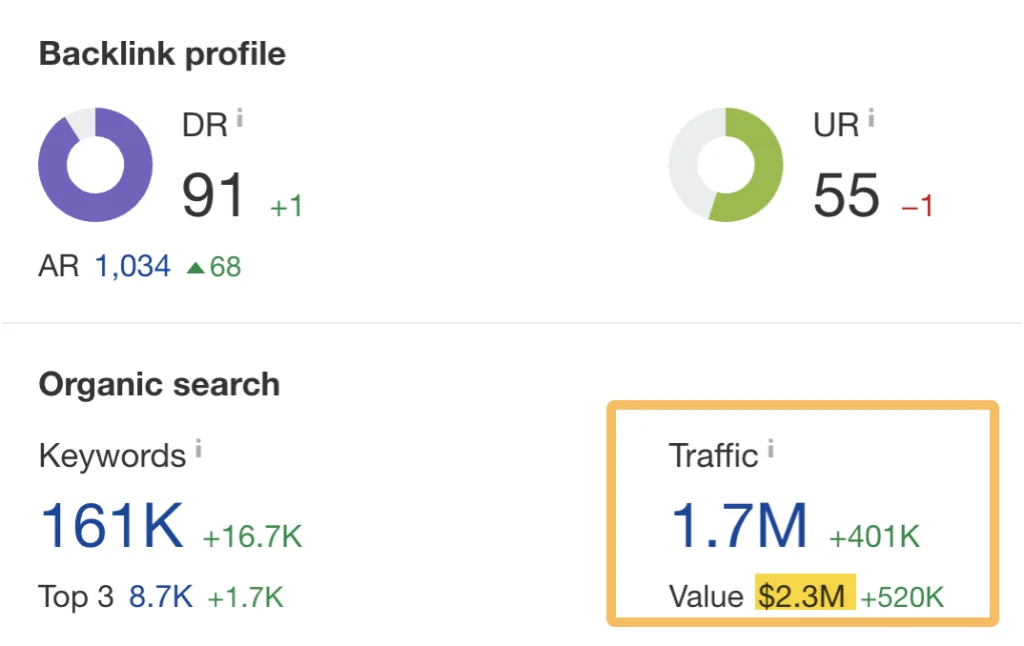
You can see from this example why improving SEO and increasing your organic traffic can be a highly valuable investment for your business.
Getting started with SEO doesn’t always mean you have to spend a lot, either. If you are willing to learn about SEO basics, you can do a lot of the work yourself to bring costs down.
RECOMMENDATION
When it comes to tools, you don’t have to spend a lot when you are starting out. You can use Ahrefs Webmaster Tools for auditing your site and our free SEO tools to optimize it further.
It’s always on—24/7
Unlike paid marketing, SEO is always on. It continues to work for you while you are asleep.
You’ll get more overall value from SEO than other marketing channels. It doesn’t cost any extra to have it running all the time.
Another benefit is that once your website is established with good rankings, SEO will maintain them over time and drive consistent traffic to your website.
The only thing that can stop this is if there is a serious technical issue with your site or you have fallen foul of Google’s search guidelines.
Reduce your dependency on PPC
It’s easy for a business to rely on pay-per-click (PPC) marketing, but it can be expensive to maintain this marketing strategy.
SEO can help you change this.
Once you have some important keywords ranking number #1 on Google, you can consider turning off some of your PPC marketing, which could result in significant savings for your business.
5. It improves user experience
Many people have high expectations for websites these days. They expect them to be clear, intuitive, and lightning-fast.
When websites don’t work as people expect, they get frustrated. And if they have a bad experience, this can create a negative perception of the brand.
To do well in SEO, you’ll need to provide your visitors with the best possible user experience.
But how can you optimize for user experience in SEO?
SEOs typically divide user experience issues into three categories:
- Site speed
- Core Web Vitals
- On-site optimization
Let’s take a closer look.
Site speed
Site speed is one of the most critical factors for your visitors. If your website is slow to use, visitors will likely leave your site and probably not return.
A few years ago, Google tested 900,000 websites worldwide. It reported that 53% of people would leave a website if it took three seconds or more to load.
SIDENOTE.
Google has suggested that improving site speed just by one second can help boost your conversion rate by 27%.
To test your site speed, you can use a tool like webpagespeedtest.org. Let’s take a look at Ahrefs speed metrics using this tool.

We can see above that the speed index is under three seconds for Ahrefs. If your website loads in more than three seconds, then you may want to consider speeding up your website.
RECOMMENDATION
If you use WordPress, check out our guide on how to speed up WordPress.
Core Web Vitals
Core Web Vitals are Google’s quality signals it introduced to quantify the user experience of your website.
They are:
- Largest Contentful Paint (LCP) – For load performance.
- First Input Delay (FID) – For visual stability.
- Cumulative Layout Shift (CLS) – For interactivity.
Here’s what Google classifies as good and bad scores for these metrics.
| Good | Needs improvement | Poor | |
|---|---|---|---|
| LCP | <=2.5s | <=4s | >4s |
| FID | <=100ms | <=300ms | >300ms |
| CLS | <=0.1 | <=0.25 | >0.25 |
Defining metrics for user experience is a benefit, as website owners can know exactly how their websites perform against Google’s expectations.
Monitoring Core Web Vitals and site performance may sound technical, but you can keep an eye on them using Ahrefs’ Site Audit.
For example, here’s a screenshot from the Performance dashboard highlighting two issues with CLS and LCP.

As you can see from the above, Site Audit automatically identifies all low-performing pages for you.
On-page optimization
On-page optimization is another area of SEO that can help benefit your website. With on-page optimization, SEOs critically examine your website and audit it for any issues that may impact the user experience.
A good example of on-page optimization is adding subheadings, or heading tags, to your articles. Adding subheadings makes your content easier to read by establishing a visual hierarchy.

On-page optimization is less quantifiable than Core Web Vitals, but spending time on it will pay dividends for your website in the long run.
Ahrefs’ Site Audit can monitor headings, image alt text, internal linking, and other on-page optimization factors.
Here’s an example of a scheduled report you can get for heading optimization opportunities.

You can use this report to identify many improvement opportunities for your website.
6. It puts your store online
If your business has a physical store, you can add it to a Google Business Profile for free.
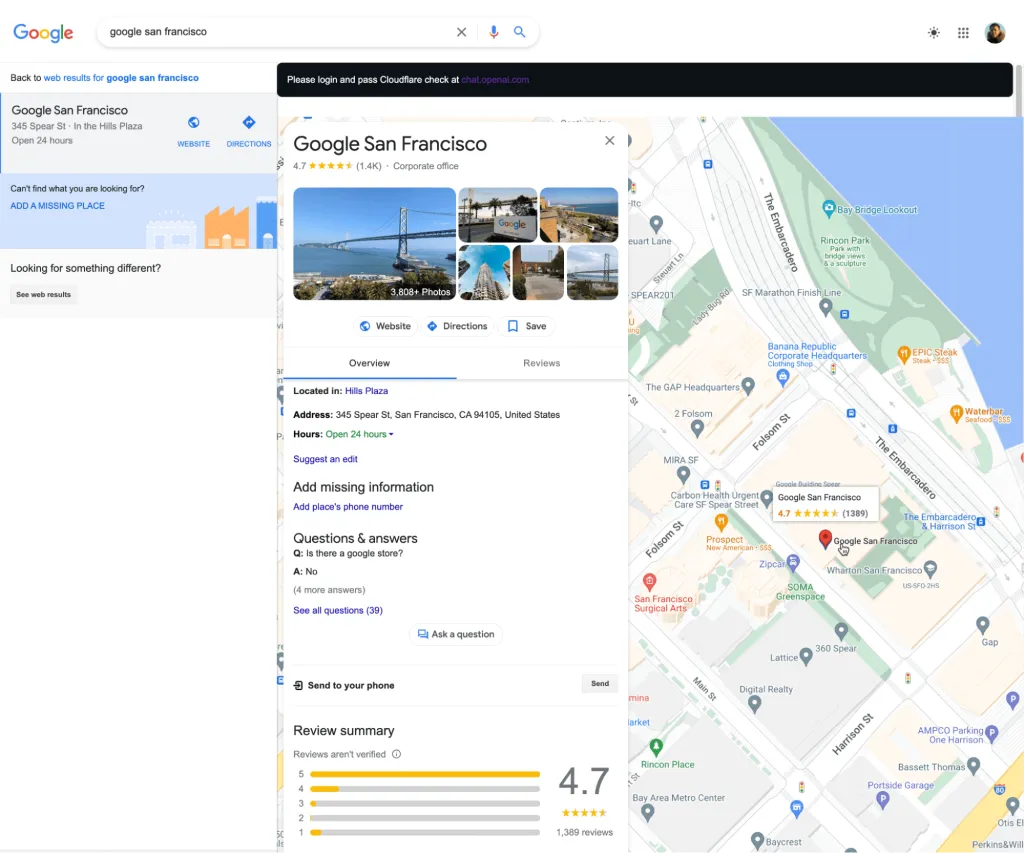
Adding your business to Google’s business listings means you will appear on Google Maps when someone searches for your business or related keywords.
It’s a great way to highlight your business locally. For some businesses focused on local trade, this listing can be one of their most crucial organic search assets.
It also gives you a helpful way to communicate your business hours and opening times to your customers—something they will appreciate.
By having a solid organic presence and utilizing tools such as Google Business Profile, you can be sure that your online business will pick up sales even when you can’t open your physical store.
So how do you set up your own Google Business Profile listing?
Setting up a Google Business Profile is straightforward and a three-step process.
- Claim your business profile
- Add your business hours and details
- Manage your profile, share any business updates, and respond to customer reviews
Once you have done this, you can monitor your business profile’s performance with the built-in analytics.
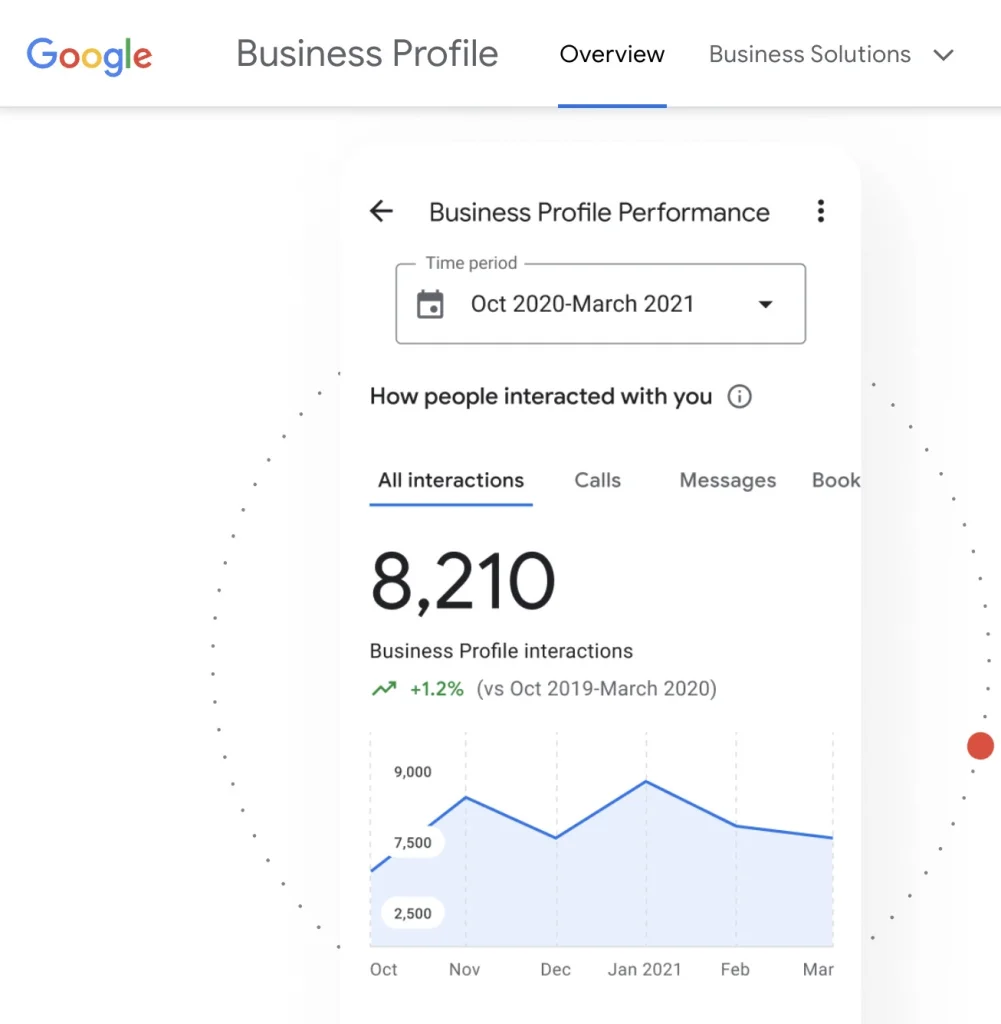
Using a Google Business Profile allows you to discover how people are searching for your website and helps you to understand how your business connects with customers online.
7. It builds trust
Building trust with customers is just as important online as it is offline. You wouldn’t buy something from a physical shop if the shop was run-down and the service was poor.
The same applies to websites.
Your website should be fully operational and perform well in search engines. It should be secure and provide a great user experience to your customers.
Having good SEO on your website shows you’re an authority in your industry. It shows you have the information and expertise customers are looking for.
It also means searchers will click on your website in the results because it is more prominent than your competitors—you will get the customers, and they won’t.
The bottom line here is that by improving your website’s SEO, more visitors will trust your brand, which will drive more traffic and sales.
Learn more
Now you know the key benefits of SEO, you may want to start learning about it in more detail.
I’ve collected some helpful resources below to help you get started, so you can learn about SEO and start to reap the benefits:
- The Ahrefs Academy – Browse all our top video tutorials.
- Beginner’s SEO Guide – Start here if you are new to SEO and want to read more about it.
- Blogging for Business – If you own a business, you must check out Tim Soulo’s video course.
- Ahrefs’ YouTube Channel – Sam Oh’s videos are the best SEO videos (remember to like and subscribe!).
Source from Ahrefs
Disclaimer: The information set forth above is provided by Ahrefs independently of Alibaba.com. Alibaba.com makes no representation and warranties as to the quality and reliability of the seller and products.




